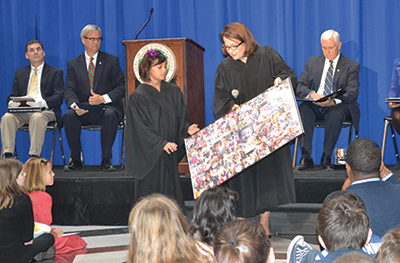For many years, those working in the juvenile justice system have been concerned with the children that are involved with, and have needs in, both the juvenile delinquency and child welfare systems.
Juvenile judges, juvenile probation officers and Department of Child Services’ case managers have lamented for years the imaginary firewall that existed between juvenile probation department and department of child welfare services and that these children were tagged with labels like “chilinquents” because of their dual needs.
The teenage girl who repeatedly runs away and fails to attend school is labeled a juvenile delinquent in the juvenile delinquency system. What if she ran away because she was being molested nightly by her mother’s boyfriend? The child welfare system should be involved, but it was not in our system as it existed one year ago. However, the stars began to align to bring about significant change to address this systemic deficiency.
The winds of change first blew in 2009 when the Indiana Judicial Conference Juvenile Justice Improvement Committee appointed a task force to begin discussions with representatives of the Department of Child Services on issues related to Crossover Youth. A 2010 survey of the five most populated counties revealed: 1) meaningful data was not available; 2) there was a lack of collaboration between the agencies; 3) a need for cross-training of providers in the delinquency and child welfare systems; and 4) participants could not easily identify cases that could be classified as crossover or dual jurisdiction cases.
The survey also revealed that each agency perceived that the responsibility for such cases was not shared, but shifted with a lack of collaboration. This perception was consistent with the national research that indicated that there exists a “systems paradigm” that each system must operate to the exclusion of the other.
The national data reveals that approximately 10 – 20% of all cases involving youth have points of contact in both systems. Although the winds of change rustled with the survey, systemic reform did not take hold because the task force did not have agency cross-representation; there was a lack of leadership across both systems that were committed to reform; and political support was polarized on greater issues confronting children at the time. How did Indiana’s Dual Status legislation become a reality? The stars aligned.
New leadership in key state agencies changed the political climate necessary for this type of restorative juvenile reform. Appointed in 2012, and subsequently selected as Chief, Supreme Court Justice Loretta Rush was a former trial court judge hearing juvenile cases.

One of Chief Justice Rush’s first initiatives was working with the Indiana Commission on Improving the Status of Children in Indiana signed into law by Governor Pence in 2013. This unique legislation mandated the participation of State Department heads and studied issues concerning vulnerable youth, reviewed legislation, and promoted information sharing and best practices.
Mary Beth Bonaventura, Director of the Department of Child Services, and herself a former juvenile court judge, also joined in this effort.
The Commission created the Cross-Systems Task Force chaired by Judge Charles Pratt, Allen Superior Court, and Donald Travis, Indiana Department of Child Services. The Task Force consisted of representatives from the Department of Mental Health, Education, Law Enforcement, Placement Agencies, Public Defenders and the Indiana Bar which promoted and endorsed the development of cross system processes.
The stars came in full alignment in 2014 when an Indiana team, including State Representative Wendy McNamara, went to the Pew Commission meeting in Vermont. At the same time, Casey Family Programs was seeking proposals for Judicial Engagement and approached Judge Mary Willis, Henry Circuit Court 1, then President of the Indiana Council of Juvenile and Family Court Judges (ICJFCJ).
In January 2015, Representative McNamara met with Judges Pratt and Willis to draft legislation to make this vision a reality using the Casey Family Programs’ Crossover Youth Practice model as a template.
The legislation was supported and made possible by the collaborative efforts of the Department of Child Services, ICJFCJ, Juvenile Justice Improvement Committee, Indiana Prosecuting Attorneys Council, Public Defender Council, Court Appointed Special Advocates, the Indiana State Bar Association and the Commission on the Status of Improving Children. With minimal fiscal impact and additional collaboration, the bill ultimately passed with unanimous bi-partisan support from the Indiana legislature. HEA 1196 was signed into law by Governor Pence with an effective date of July 1, 2015.
As part of the Casey Judicial Engagement project, five pilot counties have embarked on fueling the success of the legislation. Dubbed the TEACH Counties, these counties and judicial officers are as follows: Tippecanoe County: Judge Faith Graham, Elkhart County: Magistrate Deborah Domine, Allen County: Judge Charles Pratt, Clark County: Judge Vicki Carmichael, Henry County: Judge Mary Willis.
Following working site visits to Austin, Texas; Youngstown, Ohio, and Seattle, Washington, these counties have developed internal processes customized for each county, created a Memorandum of Understanding with the assistance of the Department of Child Services to share information and draft forms and orders.
In tandem with these counties, Marion County was awarded a grant to work on Dual Status Youth with the Robert F. Kennedy Children Action Corps, and under the leadership of Judge Marilyn Moores and Magistrate Gael Deppert, have conducted in-depth research to generate important data to guide the cross-system youth processes.
The Indiana legislation encompasses and defines 1) dually identified youth who are currently involved in one system and have a history in the other system; 2) dually involved youth who have concurrent involvement in both the child welfare and juvenile justice system; and 3) dually adjudicated youth who are adjudicated in both systems and originating in either the child welfare or delinquency systems.
Indiana is unique in its inclusion of children who are eligible for release from department of correction commitment whose parents cannot be located or are unwilling to take custody of the child.
A flowchart was developed to map the path of these youth starting with a “Dual Status Screening Tool” where the juvenile probation officer or family case manager are able to identify if any dual status “markers” exist for the presenting child.
These markers are identified through a coordinated computer search utilizing all available case management systems including Quest, Odyssey, Kidstrack and MaGIK. This search is defined as a “factual review of the child’s status and history” to determine points of cross over between the two systems. For example, a child with multiple cases in one system only would not have dual markers in both systems. This report along with the petition is filed with the Court along with a recommendation regarding a referral to a Dual Status Team.
The judge reviews the report and recommendation and determines, after considering relevant factors, if the petition should be deferred and the case referred to a Dual Status Team for assessment. The screening can also be conducted following adjudication as a child in need of services or delinquent child at which time a referral can be made to the team. The team consists of a probation officer, a family case manager and a designated facilitator.
The Court has discretion to appoint additional members of the team that will assist in making recommendations for the child after considering specific statutory factors designed to assess the child’s current status, best interests, need for services and level of strengths and risks. The team convenes and shares relevant information regarding the child and makes a recommendation regarding the best course for the child in the juvenile justice and child welfare systems.
The Dual Status Assessment Team meeting is confidential and the team prepares a report for the court regarding the specific recommendations and designating the lead agency as either the juvenile probation department or the Department of Child Services.
The Court considers those recommendations and issues an Order making findings regarding dual status and ordering appropriate services available in either the child welfare or juvenile delinquency systems. The recommendations can include additional testing, referral to services, recommendations for a modification of an existing dispositional order or the filing of additional petitions including an informal adjustment. Designating a lead agency does not relieve the other agency of ongoing responsibility. The collaboration of the agencies continues until the conclusion of the child’s case.
The Dual Status model is not a procedure which merely requires more paperwork. It is an ongoing process of collaboration that embraces fully the concepts of restorative justice for all children. These are Indiana’s children and their dual status means they need us twice as much.
Additional training on the Dual Status legislation will be provided in 2016 to the Juvenile Probation Officers and juvenile judicial officers at their annual trainings.
